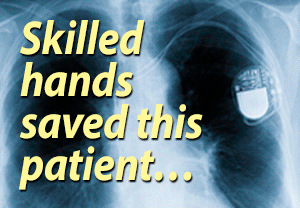 Pacemaker tracking during exercise - can it be adjusted?
Pacemaker tracking during exercise - can it be adjusted?
- by quikjraw
- 2021-03-07 09:48:15
- Exercise & Sports
- 1143 views
- 5 comments
Hi all
had a really good conversation with a new EP technician last week and he explained a lot and is very open to changes. He was very patient and let me ask a lot of questions.
I could sense he was busy so I let him go before asking him to explain one point he said that I have since looked up and still struggling to understand.
He said that he could see I was getting my heart rate up nicely and that it "was tracking consistently at 1:1". I know that 1:1 to means that for every atrial event a ventricular event was occuring.
What I did not appreciate is that I think he meant the pacemaker was doing this and that it can provide me with a ventricular beat at heart rates probably as high as I need (180 to 190ish).
I have no idea if my block is present during exercise (I suspect it is not) but I assume at this stage they do not want to take any chances.
I am now certain that during exercise (I have now been running 3 times a week since January) I am not as efficent as before the pacemaker was fitted. I'd say I'm about a third less efficient than I was only four months ago. I strongly suspect that this is primarily due to the ventricular beats during exercise being forced by my settings to be tracked by the pacemaker rather than allowing my intrinsic beat to activate. I suspect the paced beat during exercise is not as efficient as my own beat, assuming it is present during exercise.
When I next go back to the EP technician what options do they have to reduce this forcing of the ventricular pacing during exercise assuming I do not have a block during exercise?
I've started reading the section on PVARP in the Medronic but I do not understand all the terms yet so cannot make head nor tail of what it is saying.
I know you might say I might have a block during exercie but for the purpose of this discussion let's say I do not to keep things simple.
5 Comments
when it paces
by Tracey_E - 2021-03-07 11:31:02
If you are not in block during exercise, it won't pace ventricle. The pacer always gives your heart a fraction of a second to beat on its own before it paces. It's reactive, not proactive. t's easy for them to look at the printout and see if you are pacing during exercise.
A good technician that listens is worth their weight in gold!
PVARP
by Selwyn - 2021-03-07 12:14:11
hi Quikjraw
Post ventricular atrial refractory period is the interval after a ventricular paced or sensed event during which an atrial event cannot initiate a new atrioventricular interval (ie.the interval between an atrial event and the scheduled delivery of a ventricular stimulus)
The purpose of having PVARP is to stop the inappropriate atrial sensing of ventricular events and backwards flow of ventricular electrical activity ie. it is a blanking mechanism. If the interval is too short you can get what is called 'cross talk', which is basically like feedback of sound! Not nice!!! ( resulting in so called pacemaker mediated tachycardia).
So, if you want to get a faster heart rate the blanking interval needs to shorten, hence the information that Gemita has kindly provided. The clever pacemaker people have an automatic adjustment mechanism of PVARP to help people like yourself who want a higher heart rate.
I am pleased you followed my advice to chat to the PM technician. They are happy to have someone to appreciate their learning. It sounds like you were nice to them (appreciating their time pressure) and they were nice to you. The basis of a good relationship!
Further to your comment, " I know you might say I might have a block during exercise, but for the purpose of this discussion, let's say I do not to keep things simple". I am not sure you want to go down that pathway without speaking to your cardiologist who would know more about what is happening to your heart with exercise. That would be my next port of call. Remember, if your heart does function without block at higher heart rates, you can always have the upper rate limit lowered and then your own natural rhythm hopefully will take over.
I hope this helps the understanding of some of the language of pacing.
Pleased you are getting sorted. Best to try out small changes and then go to the next stage if you are happy.
Thanks
by quikjraw - 2021-03-07 15:17:32
Thanks Therese it was a real difference of discussion! Very pleased.
Selwyn that is so useful I read two different websites but your explanation is far more clear.
What would the name of the setting be to modify the AV delay when heart rate increases?
My AV delay for AAI>DDD is set at maximum of 500ms but I presume it shortens with increasing heart rate?
My AV delay settings if of interest
by Gemita - 2021-03-07 15:33:25
John,
Not a specialist here of course but to try to answer your question:
AV delay should shorten apparently as heart rate increases. The settings to adjust I would suggest are the AV delay settings(?). Mine set:
AV delay sensed in ms 150
AV delay paced in ms 180
You should ask whether your AV delay settings are set appropriately for your particular exercise requirements I believe?
You know you're wired when...
Your kids call you Cyborg.
Member Quotes
Do feel free to contact the manufacturer of your device. I have found them to be quite helpful when I have had questions and concerns.




You are making progress
by Gemita - 2021-03-07 10:44:07
https://www.medtronicacademy.com/features/automatic-pvarp-feature
Hi John,
Just caught your post. Am really delighted you had a valuable chat with a new EP technician. Perhaps you won't need to find a new EP or device team to look after you in the future. This could make all the difference.
I thought I would post the Medtronic description link of PVARP for anyone who wants to know what it means (including me!) and I look forward to hearing comments from others in answer to your post.
Good luck - it sounds as though you might be making some progress at last